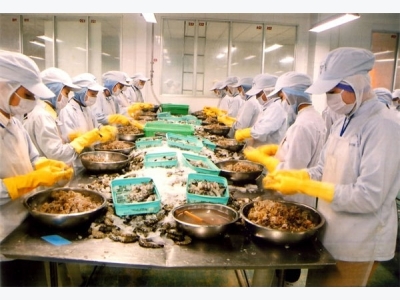Shrimp prosper in mixed ponds

Breeding shrimp together with other aquatic products is preventing disease without using chemicals and providing sustainable results for farmers in the central coastal province of Phu Yen.
Workers process shrimps for export in the central province of Phu Yen. Breeding shrimp together with other aquatic products is providing sustainable results for farmers in the province.
In the past, breeding black-tiger shrimp and white shrimp at high density resulted in epidemics that forced breeders to use chemicals to treat polluted water. Now the province has implemented effective combined breeding models, which helps to minimise pollution.
According to tests conducted by the Dong Hoa District’s veterinary laboratory, shrimp bred there were mainly infected with acute liver-and-marrow necrosis, and white-spot and red-body disease.
To limit the epidemic and environmental pollution, shrimp breeders have been breeding shrimp with other aquatic products, such as blue crab, tilapia.
"I am breeding tilapia with shrimp in a family pond. I see the water environment in the pond is better than previous years when I bred only shrimp,” said shrimp breeder Nguyen But of Hoa Tam Commune.
“The pond’s bottom is no longer polluted by food leftovers, while the shrimps grow rapidly. Although the profit is lower than the model of only shrimp breeding, I earn VND100million (US$4,400) to VND120 million from 5 sao (1 sao equals 360sq.m) of water surface per crop. Every year I can raise two crops and the water environment is still guaranteed."
Another shrimp breeder, Huynh Hung of Hoa Hiep Nam Commune, who is breeding shrimp and blue crabs, said "Firstly, I feed baby shrimp with microbiology fermented bran, and the shrimp’s growth is very good. After 15 days, I give them industrial feed," Hung said.
Do Kim Dong, chief of Dong Hoa District’s agriculture department, said that in 2016, local authorities supported 600kg of baby tilapias for shrimp farmers in four communes and towns to develop the combined model of shrimp breeding.
“Tilapias can consume feed leftovers, limiting water pollution," Dong said.
Meanwhile, in neighbouring district of Tuy An, shrimp farmers are breeding shrimp together with oysters, blue crabs, seaweed and fish.
Tran Sau, head of Tuy An District’s agriculture department said "The combined shrimp raising model is bringing profit to breeder. The model is suitable for environmental condition of O Loan Lagoon.”
Expanding model
Over the past few years, Phu Yen Province’s Agricultural Promotion Centre has built up several aquatic-product breeding models that utilises new and advanced technology.
Nguyen Khac Tan, the centre’s deputy director, said from 2010 to 2012, farmers in two communes Xuan Loc and Ha Xuan Dong were the first in the province to breed shrimp together with tilapias and seaweed. The combination created clean water and limited the penetration and development of disease bacteria.
The centre has also developed combination models of black-tiger shrimp (also called prawn in Europe) and blue crabs in Song Cau Town, and black-tiger shrimp with sea cucumber in Xuan Hai Commune.
Another model developed by the centre was VietGAP-standard shrimp breeding in Hoa Hiep Nam Commune of Dong Hoa District.
"Each model has its advantages and disadvantages. Therefore, although most models have been implemented and proved sustainable effectiveness, technicians and experts must evaluate what model will be suitable for each farming area," Tan said.
Phu Yen Province’s Department of Agriculture and Rural Development director Nguyen Trong Tung says the province’s overall goal is to develop its shrimp breeding industry into a large-scale model, adaptable to climate change and ecologically friendly. In the 2017-20 period, total shrimp farming area in the province is estimated to reach about 1,940ha.
The department also requested local agricultural departments to complete detailed planning for shrimp breeding and infrastructure investment soon in order to bring into full play the potential for sustainable shrimp farming.
Có thể bạn quan tâm
 US soybean farmers aim for sustainability in aquaculture feed
US soybean farmers aim for sustainability in aquaculture feed Farmers looking to cut environmental impacts to make soy fish feed even more sustainable.
 As prices fall, warmwater shrimp claims dominance on UK shelves
As prices fall, warmwater shrimp claims dominance on UK shelves Total shrimp retail sales hit £443.3 million (€506.1 million/$564.7 million) during the period, while volumes reached 32,225 metric tons.
 The search for better baby shrimp
The search for better baby shrimp Vietnam has made great progress in breeding brackish-water shrimp, becoming the world’s third largest shrimp exporter with annual value of more than US$3 billio